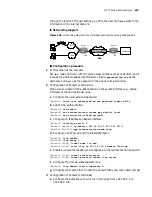
614
C
HAPTER
43: C
ONFIGURING
L2TP
information (ACK) and wait for some time before clearing the tunnel, so that the
request transmitted again from the peer can be properly received when ACK
message is lost. After disconnecting the tunnel by force, all control connections
and session connections on the tunnel will also be cleared. After tunnel
disconnection, a new tunnel will be established again when new users dial in.
Perform the following configuration in system view.
Table 679
Force to Disconnect Channel
Configure to Force the
Local End to Implement
CHAP Authentication
This configuration is applicable to LNS only.
After LAC performs the proxy authentication for dial-up users, LNS can
authenticate these users again. In this case, the users will be authenticated twice,
the first authentication being at LAC and the second one at LNS side. Only after
passing both of the authentications can the L2TP tunnel be established.
In actual L2TP application, there are three methods of authentication: proxy
authentication, forcing CHAP authentication and LCP renegotiation.
■
The priority of LCP renegotiation has the highest priority among the three
types, which means if LCP renegotiation and forcing CHAP authentication are
configured at LNS at the same time, L2TP will adopt LCP renegotiation first and
then use authentication methods configured on corresponding virtual
template.
■
If only forcing CHAP authentication is configured, LNS will authenticate users
by means of CHAP. Only after user name, password and authentication are
configured at LNS, and AAA function is enabled, can the process of forcing
CHAP authentication locally take effect.
■
If neither LCP renegotiation nor forcing CHAP authentication is configured, LNS
will perform the proxy authentication for the users. In this case, LAC conveys all
the authentication information received from users and the information
configured at LAC itself to LNS, and LNS will authenticate users according to
the information and authentication mode of LAC. When proxy authentication
is used at LNS, if LAC is configured with PAP, while the virtual interface
template at LNS is configured with CHAP, which is higher than PAP, the process
of authentication fails all the time and no sessions can be created.
If the
aaa authentication-scheme ppp default none
is configured at LAC side,
the AAA authentication will not be enabled, no matter whether PAP or CHAP
authentication is adopted at LAC side. However, after the authentication mode is
transmitted to LNS, LNS will still authenticate the user, no matter whether LNS is
configured with
aaa-enable
command.
Perform the following configurations in L2TP group view.
Operation
Command
Force to disconnect tunnel
reset l2tp tunnel
remote-name
Summary of Contents for 3036
Page 1: ...http www 3com com 3Com Router Configuration Guide Published March 2004 Part No 10014299 ...
Page 4: ...VPN 615 RELIABILITY 665 QOS 681 DIAL UP 721 ...
Page 6: ...2 ABOUT THIS GUIDE ...
Page 7: ...I GETTING STARTED Chapter 1 3Com Router Introduction Chapter 2 3Com Router User Interface ...
Page 8: ...4 ...
Page 16: ...12 CHAPTER 1 3COM ROUTER INTRODUCTION ...
Page 34: ...30 ...
Page 60: ...56 CHAPTER 3 SYSTEM MANAGEMENT ...
Page 98: ...94 CHAPTER 6 DISPLAY AND DEBUGGING TOOLS ...
Page 110: ...106 ...
Page 114: ...110 CHAPTER 8 INTERFACE CONFIGURATION OVERVIEW ...
Page 158: ...154 CHAPTER 10 CONFIGURING WAN INTERFACE ...
Page 168: ...164 ...
Page 188: ...184 CHAPTER 13 CONFIGURING PPPOE CLIENT ...
Page 192: ...188 CHAPTER 14 CONFIGURING SLIP Router ip route static 0 0 0 0 0 0 0 0 10 110 0 1 ...
Page 248: ...244 CHAPTER 16 CONFIGURING LAPB AND X 25 ...
Page 320: ...316 ...
Page 330: ...326 CHAPTER 20 CONFIGURING IP ADDRESS ...
Page 362: ...358 CHAPTER 21 CONFIGURING IP APPLICATION ...
Page 374: ...370 CHAPTER 23 CONFIGURING IP COUNT ...
Page 406: ...402 CHAPTER 25 CONFIGURING DLSW ...
Page 408: ...404 ...
Page 452: ...448 CHAPTER 29 CONFIGURING OSPF ...
Page 482: ...478 CHAPTER 30 CONFIGURING BGP ...
Page 494: ...490 CHAPTER 31 CONFIGURING IP ROUTING POLICY ...
Page 502: ...498 ...
Page 508: ...504 CHAPTER 33 IP MULTICAST ...
Page 514: ...510 CHAPTER 34 CONFIGURING IGMP ...
Page 526: ...522 CHAPTER 36 CONFIGURING PIM SM ...
Page 528: ...524 ...
Page 532: ...528 CHAPTER 37 CONFIGURING TERMINAL ACCESS SECURITY ...
Page 550: ...546 CHAPTER 38 CONFIGURING AAA AND RADIUS PROTOCOL ...
Page 590: ...586 CHAPTER 40 CONFIGURING IPSEC ...
Page 599: ...IX VPN Chapter 42 Configuring VPN Chapter 43 Configuring L2TP Chapter 44 Configuring GRE ...
Page 600: ...596 ...
Page 638: ...634 CHAPTER 43 CONFIGURING L2TP ...
Page 649: ...X RELIABILITY Chapter 45 Configuring a Standby Center Chapter 46 Configuring VRRP ...
Page 650: ...646 ...
Page 666: ...662 ...
Page 670: ...666 CHAPTER 47 QOS OVERVIEW ...
Page 700: ...696 CHAPTER 49 CONGESTION MANAGEMENT ...
Page 706: ...702 CHAPTER 50 CONGESTION AVOIDANCE ...
Page 707: ...XII DIAL UP Chapter 51 Configuring DCC Chapter 52 Configuring Modem ...
Page 708: ...704 ...
Page 762: ...758 CHAPTER 52 CONFIGURING MODEM ...















































